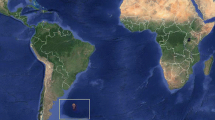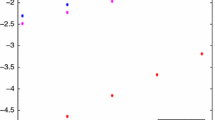Abstract
Spatial-depth functional regression is applied for the estimation of ocean temperature, with projection onto the eigenvectors of the empirical covariance operator of the functional response (i.e., onto the Empirical Orthogonal Functions in space and depth). Moment-based estimation is performed to approximate the regression operators in the subspace generated by the empirical eigenvectors associated with nonnull eigenvalues. In addition, Bayesian estimation is performed to approximate the regression operators in the subspace generated by the empirical eigenvectors associated with almost null eigenvalues. The cross-validation results obtained, together with the spatial-depth residual correlation analysis carried out on a real data set for the South Atlantic area, to the east of Argentina and the Falkland Islands, represent an improvement on those provided by the wavelet-based approach recently proposed in Fernández-Pascual (Stoch Environ Res Risk Assess 30:523–557, 2016).











Similar content being viewed by others
References
Angelini C, De Canditiis D, Leblanc F (2003) Wavelet regression estimation in nonparametric mixed effect models. J Multivar Anal 85:267–291
Baladandayuthapani V, Mallick B, Hong M, Lupton J, Turner N, Caroll R (2008) Bayesian hierarchical spatially correlated functional data analysis with application to colon carcinoginesis. Biometrics 64:64–73
Basse M, Diop A, Dabo-Niang S (2008) Mean square properties of a class of kernel density estimates for spatial functional random variables. Annales De L’I.S.U.P. Publications de l’Institut de Statistique de l’Université de Paris, Paris
Ben-Israel A (1966) A Newton–Raphson method for the solution of system of equations. J Math Anal Appl 15:243–252
Deuflhard P (1974) A modified Newton method for the solution of ill-conditioned systems of nonlinear equations with application to multiple smoothing. Numer Math 22:289–315
Fan J, Zhang JT (2000) Two-step estimation of functional linear models with applications to longitudinal data. J R Stat Soc Ser B 62:303–322
Fernández-Pascual R, Espejo RM, Ruiz-Medina MD (2016) Moment and bayesian wavelet regression from spatially correlated functional data. Stoch Environ Res Risk Assess 30:523–557
Giraldo R, Delicado P, Mateu J (2010) Continuous time-varying kriging for spatial prediction of functional data: an environmental application. J Agric Biol Environ Stat 15:66–82
Gneiting T (2002) Non-separable, stationary covariance functions for spacetime data. J Am Stat Assoc 458:590–600
Gneiting T, Kleiber W, Schlather M (2010) Mattèrn cross-covariance functions for multivariate random fields. J Am Stat Assoc 105:1167–1177
Mardia KV, Goodall C (1993) Spatial-temporal analysis of multivariate environmental monitoring data. In: Patil GP, Rao CR (eds) Multivariate environmental statistics. North Holland, Amsterdam, pp 347–386
Mosammam AM (2015) The reverse dimple in potentially negative-value space–time covariance models. Stoch Environ Res Risk Assess 29:599–607
Nerini D, Monestiez P, Manté C (2010) Cokriging for spatial functional data. J Multivar Anal 101:409–418
Porcu E, Gregori P, Mateu J (2006) Nonseparable stationary anisotropic space- time covariance functions. Stoch Environ Res Risk Assess 21:113–122
Porcu E, Zastavnyi V (2011) Characterization theorems for some classes of covariance functions associated to vector-valued random fields. J Multivar Anal 102:1293–1301
Ruiz-Medina MD (2011) Spatial autoregressive and moving average Hilbertian processes. J Multivar Anal 102:292–305
Ruiz-Medina MD (2012) Spatial functional prediction from spatial autoregressive Hilbertian processes. Environmetrics 23:119–128
Ruiz-Medina MD, Espejo RM (2012) Spatial autoregressive functional plug-in prediction of ocean surface temperature. Stoch Environ Res Risk Assess 26:335–344
Ruiz-Medina MD, Espejo RM (2013) Integration of spatial functional interaction in the extrapolation of ocean surface temperature anomalies due to global warming. Int J Appl Earth Obs Geoinf 22:27–39
Ruiz-Medina MD, Frías MP (2015) Wavelet-based semiparametric estimation of ocean surface temperature. Math Geosci 47:149–171
Ruiz-Medina MD, Angulo JM, Christakos J, Fernández-Pascual R (2016) New compactly supported spatiotemporal covariance functions from SPDEs. Stat Methods Appl 25:125–141
Sandwell DT (1987) Biharmonic spline interpolation of GEOS-3 and SEASAT altimeter data. Geophys Res Lett 14:139–142
Sigrist F, Kunsch HR, Stahel WA (2015) Stochastic partial differential equation based modelling of large space–time data sets. J R Stat Soc Ser B-Stat Methodol 77:3–33
Yang WH, Wikle CK, Holan SH, Sudduth K, Meyers DB (2015) Bayesian analysis of spatially-dependent functional responses with spatially-dependent multi-dimensional functional predictors. Stat Sin 25:205–223
Acknowledgments
This work was supported in part by projects MTM2012-32674 (cofinanced with FEDER funds) and MTM2015–71839–P of the DGI, MINECO, Spain. We would like to thank the guest editors for their support for the research area of Spatial Functional Statistics.
Author information
Authors and Affiliations
Corresponding author
Appendix
Appendix
In this section we show the computations to be developed to obtain the Bayes estimators of the coefficients of the regression operators with respect to the eigenvectors associated with the smallest eigenvalues of the covariance operator of the response.
For each \(j=M+1, \ldots , H,\) the equation system (24) can be rewritten as
Thus, for each \(j=M+1, \ldots , H,\) the Bayes estimator of the parameter vector \((\lambda _{j}(\mathcal {K}_{1}),\lambda _{j}(\mathcal {K}_{2}),\lambda _{j}(\mathcal {K}_{3})),\) the generalised maximum likelihood estimator given by the mode of the posterior, is obtained as the solution to the following system of non-linear equations:
where
The non-linear system of Eq. (27), in the parameters \(\lambda _{j}(\mathcal {K}_{1}),\) \(\lambda _{j}(\mathcal {K}_{2})\) and \(\lambda _{j}(\mathcal {K}_{3}),\) for each \(j=M+1, \ldots , H,\) can be solved by applying the Multivariate Newton–Raphson Method.
Rights and permissions
About this article
Cite this article
Espejo, R.M., Fernández-Pascual, R. & Ruiz-Medina, M.D. Spatial-depth functional estimation of ocean temperature from non-separable covariance models. Stoch Environ Res Risk Assess 31, 39–51 (2017). https://doi.org/10.1007/s00477-016-1259-x
Published:
Issue Date:
DOI: https://doi.org/10.1007/s00477-016-1259-x




